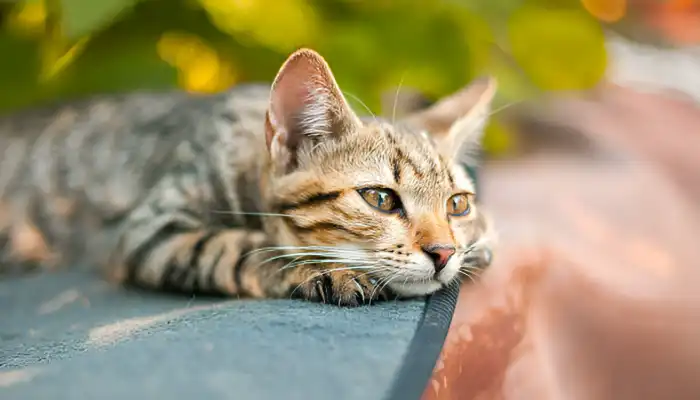How do cats say “I’m sorry”?– The way cats apologize offers significantly more subtlety than how humans and dogs do it. For example, children and dogs will cry or wag their tails to show regret without feeling ashamed. Unlike humans, a cat will express its outrage with more action than words.
Knowing how to apologize helps in creating a stronger relationship between you and your cat. Cats often emit soft purring sounds, head bumping while rubbing their bodies, changing postures, or even grooming to show affection. Let’s look at the specifics of these behaviors by cat translator.

Understanding Cat Behavior
Instead of using words, cats are more independent and rely heavily on body language. The cat’s natural movements can show remorse, but they may not meet the expectations of humans’ requirements when considering how do cats say “I’m sorry”? is considered.
- Cats are usually more independent. Unlike dogs, which need a lot of social interaction from humans, cats are more solitary and do not engage with people at the same rate.
- Cats possess a unique method of expression: Unlike humans, who portray feelings through actions or speech, cats focus on body language and other forms of non-verbal communication to convey their feelings.
- Instinct vs. Emotion: While people apologize out of regret, cats do so out of instinct. Cats tend to show specific signs when they know they’ve offended someone, although it doesn’t always correspond with how humans understand an apology.
To decipher a cat’s emotions, one must understand cat behavior. A cat does not speak and, therefore, uses body language and instincts to express itself. Cats’ mock apologies might not work for humans, but they mean something.
How Does A Cat Say I’m Sorry?
Cats can’t verbally say sorry for their actions; however, they show it through their behavior. With body movements, purring, and playful antics, cats have their way of demonstrating remorse and affection at the same time.
Acts of Your Cat That are an Indication of ‘I’m Sorry’
How do cats say “I’m sorry”? Indeed, cats cannot apologize with words; however, their actions speak for themselves. If you think your adult feline wants to apologize, consider the following behaviors that indicate remorse from your cat:
Body Postures and Movements
Declined Head: A cat tends to lower its head and avoid looking into the eyes of the human or animal they are dealing with. Such behavior seems to demonstrate submission, particularly following a disagreement.
Ears Back: When cats feel anxious or want to apologize, they will pin their ears back in a squat posture.
Cats Lowered Tail Position: Cats will often humble themselves by lowering or tucking their tails. When this happens, they are signaling submission.
Purring Alongside Nuzzling
Purring: After chaos, a cat’s gentle purring of “everything is all right” can be described with the phrase “All is Perfect.” Everything is indeed under control, and no one has stirred discord.
Nuzzling or Head-butting: How do cats say “I’m sorry”? Cats frequently tenderly head-butt their owners to make peace or apologize. A cat, draped across a carpet as if asleep, rubbing its head against a human body, almost makes it seem like it hopes for reconciliation.
Grooming Behavior
Grooming You: In an altercation, when cats nibble or lick you, it could be a sign of affection and an attempt to say “sorry.”
Self-Grooming: To calm down, cats often self-groom after being emotionally stirred. If they engage in self-grooming, they attempt to emotionally reset.
Releasing Playfulness
Change in Demeanor: Following a period of stress, your cat can become playful. This is often their way of saying, “Let’s continue to go forward,” and relieving any escalated threats.
Rather than saying sorry, cats will purr, nuzzle, and even groom you as a gesture of remorse. Seeing these signs helps us to help cats feel assured and comforted.
Common Ways Cats Show Regret
Cats show remorse through behaviors such as scratching, biting, or even knocking things over, which is often done with gentle gestures. Seeing these signs helps strengthen your bond and trust with your cat.
After the Scratching and Biting
In some cases, aggression is the effect of neglect, followed by scratching or biting. Cats are active creatures and tend to get overtly excited and aggressive. All of this is out of love, but often misplaced and comes out in the form of scratching. How do cats say “I’m sorry”? Cats display remorseful affection towards the end and try to cuddle with you to make amends as compensatory affection.
Everything You Need to Understand About Cats and Their Apologies
Knocking It All Over
Cats, being curious creatures, tend to knock over objects out of sheer boredom. If angry, they might break things around them. However, cats have a nature of showing affection and will eventually seek comfort if loved and cared for.
Disregarding You
Your cat may disregard you, but only for a short while. Subsequently, it is likely to search for you to apologize. Cats usually seek you after the discord to assure you that everything is fine and there is nothing to worry about.
What Should You Do When Your Cat Apologizes?
- Accept the Apology: If your cat is trying to reconcile, the best way to respond is by maintaining calmness. Gently caress your cat or talk to it softly in a soothing voice to let it know that you are not angry anymore.
- Don’t Punish: Cats are extremely sensitive animals. Disciplining them will make them defensive, which is dangerous for the relationship you have built with them.
- Reassurance: Gentle caressing conveys a positive attitude and trust, which helps foster a good relationship between both parties.
How to Improve Relations With Your Cat
You will continue to strengthen your bond with your cat if you
- Play with Your Cat: Cats are inherently social beings, which makes them enjoy interactions with people. Play is fun, and it also allows you to strengthen trust with your pet.
- Maintain a Healthy Climate: A cat’s life thrives on the order of things. Having a cool, steady, and comforting environment helps relieve the animal of excess stress.
Comparison with Other Animals
| Animal | Can They Feel Guilt? | How They Show It |
|---|---|---|
| Dogs | Yes | Yes – Submissive behavior, tail wagging, and licking |
| Cats | Yes | In Different Ways: Body language such as purring and grooming |
| Elephants | Yes | Social and Mourning behaviors |
Obedient purring cats seem to always obey their owners, even when what they did is wrong. But a cat’s body language certainly demonstrates some signs of guilt accompanied by a couple of actions that may be construed as regret.
Conclusion
How do cats say “I’m sorry”? Accidentally hurting a cat will prompt the feline to exhibit actions that depict regret, like lowering their heads and nuzzling, but not before they pin their ears back. These are some humble attempts by the pet to seek forgiveness.
To fully build trust with a cat, you will need a more aggressive approach to showing affection. Unlike dogs, there are many ways cats soften their boots, deepening relations without saying a word
